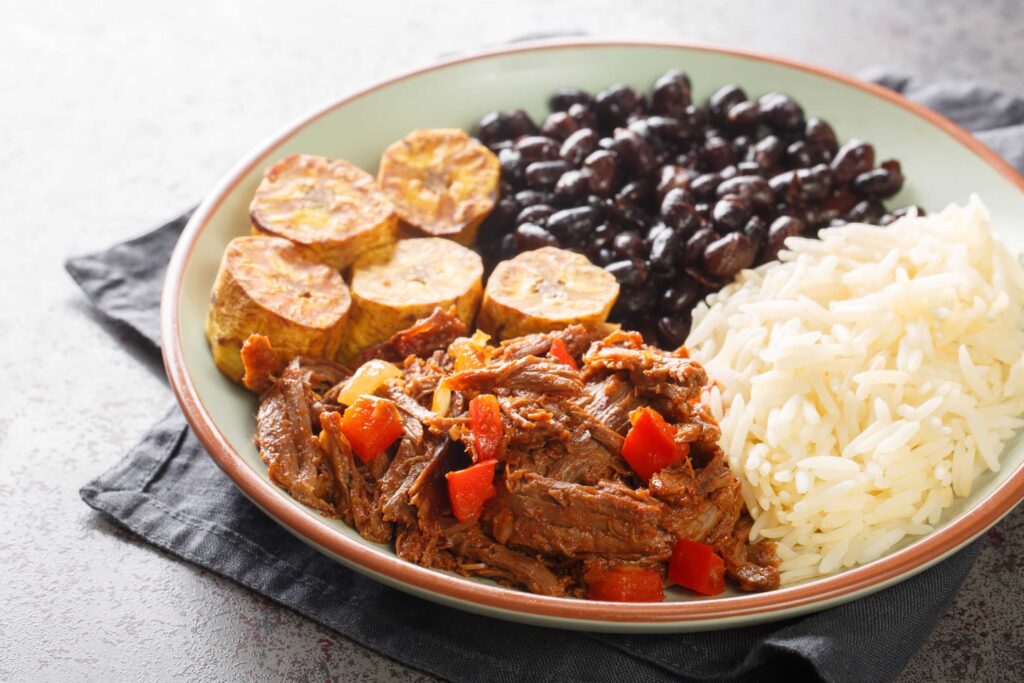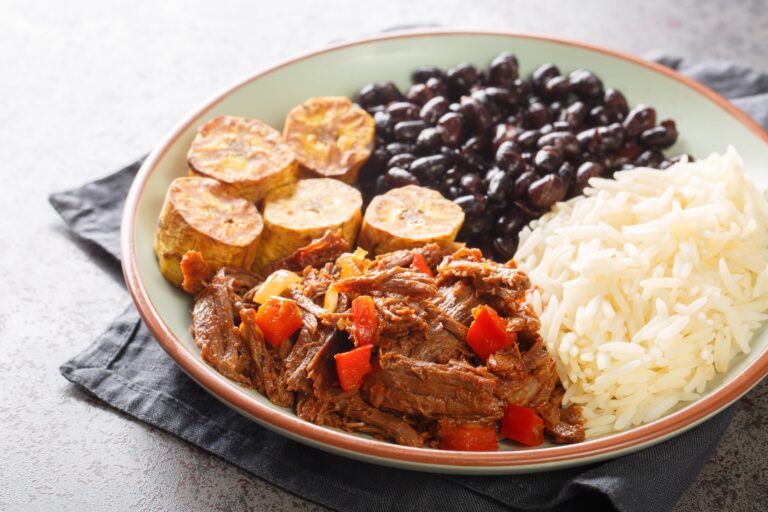
Pabellón Criollo, a dish that is as vibrant as the Venezuelan culture it hails from. It’s a meal that tells a story, reflecting the country’s history and diversity in every bite.
The origins of Pabellón Criollo are deeply rooted in Venezuela’s past. This dish, often acknowledged as the national dish of Venezuela, is a flavorful blend of shredded beef, black beans, rice, and fried plantains. Its creation dates back to colonial times when African slaves combined available ingredients to create hearty meals.
Our team at Remitly created this guide as part of our series that celebrates the traditional cuisine of our customers around the world.
The Origins of Pabellón Criollo
The name “Pabellón” translates to “pavilion”, but in this context it refers to an assortment or variety – a fitting description for this multifaceted dish. The origins of Pabellón Criollo are not entirely clear; some believe it was born out of necessity during hard times while others argue it was created by African slaves who brought their culinary traditions with them.
Regardless of its exact origin story, there’s no denying the impact Pabellón Criollo has had on Venezuelan cuisine. Over time, this humble meal has evolved into a symbol of national identity and pride.
Key Ingredients in Pabellón Criollo
At its core, Pabellón Criollo consists of four key components: shredded beef stewed in tomato sauce (carne mechada), black beans (caraotas negras), white rice (arroz blanco), and ripe plantains fried until golden brown (tajadas). Each ingredient contributes its own unique flavor and texture to the overall dish.
While these are the traditional ingredients used in making Pabellón Criollo, variations exist depending on regional preferences and availability. For instance, some regions may add cheese or eggs to their version of the dish.
Recipe for Pabellón Criollo
Pabellón Criollo is a dish that requires time and patience, but the end result is worth every minute. Here’s a simple recipe to help you recreate this Venezuelan classic at home.
Ingredients:
- 500g beef brisket
- 2 ripe plantains
- 1 cup of black beans
- 2 cups of white rice
- 1 large onion, finely chopped
- 1 bell pepper, finely chopped
- 4 cloves of garlic, minced
- 1 can of tomatoes or fresh tomatoes, chopped
- Salt and pepper to taste
- Vegetable oil for frying
Instructions:
- Start by soaking the black beans overnight. The next day, rinse them well and cook in a pot with enough water until they’re soft. This could take up to two hours.
- While the beans are cooking, prepare the beef. Place it in a pot with water and bring to a boil. Reduce heat and let it simmer until tender.
- Once the beef is cooked, shred it using two forks.
- In another pan, sauté half of the chopped onions and bell peppers with garlic until they’re soft. Add the shredded beef and canned tomatoes (or fresh ones). Season with salt and pepper.
- Let this mixture simmer on low heat for about an hour or until most of the liquid has evaporated.
- Meanwhile, cook your rice according to package instructions.
- For the plantains, peel them first then slice diagonally into thick pieces. Heat vegetable oil in a pan over medium heat then fry these slices until golden brown on both sides.
- To serve Pabellón Criollo: place a portion of rice on one side of your plate; next to it put some black beans; then add your shredded beef; finally top everything off with fried plantains. Enjoy!
Variations of Pabellón Criollo Across Venezuela
Just like any well-loved dish, Pabellón Criollo has its variations across different regions of Venezuela. In some areas, an egg is added on top for what’s known as “Pabellón a Caballo” (Pavilion on Horseback). In coastal regions where fish is abundant, shredded fish may replace beef for “Pabellón Margariteño”.
These variations not only highlight regional differences but also showcase how versatile this dish can be – adapting to local tastes while maintaining its core identity.
How Pabellón Criollo Reflects Venezuelan History
Pabellón Criollo tells a story about Venezuela’s history through its ingredients. The combination of rice from Asia, beans from indigenous cultures, beef from Europe, and plantains from Africa reflects the country’s diverse cultural influences over centuries.
Moreover, this dish embodies resilience in times of hardship – making do with available resources yet creating something deliciously satisfying. It serves as a reminder of Venezuela’s past struggles and triumphs.
The Role of Pabellón Criollo in Venezuelan Celebrations and Festivals
In Venezuela, food plays an integral role in celebrations and festivals – and Pabellón Criollo often takes center stage. Whether it’s at family gatherings, local festivals, or national holidays, this dish is a common sight.
It’s not just about the food itself but the shared experience of preparing and enjoying it together. The process of making Pabellón Criollo can be a communal activity that brings people closer – reinforcing social bonds and creating cherished memories.
Comparing Pabellón Criollo with Other Latin American Dishes
While Pabellón Criollo holds a special place in Venezuelan cuisine, it shares similarities with other Latin American dishes. For instance, Cuba has “Ropa Vieja”, a shredded beef dish served with rice and beans. Meanwhile, Puerto Rico offers “Arroz con Gandules y Pernil”, which features rice with pigeon peas and roast pork.
These dishes may differ in ingredients or preparation methods but they all share one thing in common – they’re comfort foods that represent their respective cultures.
Venezuelan Cuisine: A Melting Pot of Flavors
Venezuelan cuisine is a rich tapestry of flavors, reflecting the country’s diverse cultural influences and abundant natural resources.
Indigenous Influence
The indigenous people of Venezuela have significantly influenced its cuisine. Corn, beans, and root vegetables like yucca and potatoes are staples in many dishes. Arepas, cornmeal patties that can be filled with various ingredients, are a beloved food item across the country.
European Influence
Spanish colonization brought new ingredients to Venezuela such as wheat, beef, pork, and dairy products. These elements were incorporated into local dishes creating unique combinations like hallacas – a type of tamale made with corn dough filled with a stew of meat and vegetables, wrapped in banana leaves.
African Influence
African slaves also left their mark on Venezuelan cuisine. They introduced techniques like frying and ingredients such as plantains and coconut. One example is Cachapa – a sweet corn pancake often served with cheese or meat.
Caribbean Influence
Being part of the Caribbean region has also shaped Venezuelan food culture. Seafood is widely used along the coastlines while tropical fruits add sweetness to many dishes.
In conclusion, Venezuelan cuisine is an exciting blend of different cultures coming together through food. Each dish tells a story about its people’s history and way of life – making it not just delicious but also deeply meaningful.
Visit the homepage, download our app, or check out our Help Center to get started.
